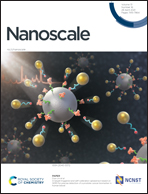Chemisorption of nitronyl–nitroxide radicals on gold surface: an assessment of morphology, exchange interaction and decoherence time†
Abstract
A combined Tof-SIMS, XPS and STM characterization has been performed to study the deposition of a sulphur-functionalized nitronyl nitroxide radical on Au(111) clearly demonstrating the chemisorption of intact molecules. Continuous -wave EPR characterization showed that the radical molecules maintain their paramagnetic character. Pulsed EPR measurements allowed to determine the decoherence time of the nanostructure at 80 K, which turned out to be comparable to the one measured in frozen solution and longer than previously reported for many radicals and other paramagnetic molecules at much lower temperatures. Furthermore, we conducted a state-of-the-art ab initio molecular dynamics study, suggesting different possible scenarios for chemisorption geometries and predicting the energetically favoured geometry. Calculation of the magnetic properties indicates a partial non-innocent role of the gold surface in determining the magnetic interactions between radicals in packed structures. This suggests that the observed EPR spectrum is to be attributed to low-density domains of disordered radicals interacting via dipolar interactions.



 Please wait while we load your content...
Please wait while we load your content...